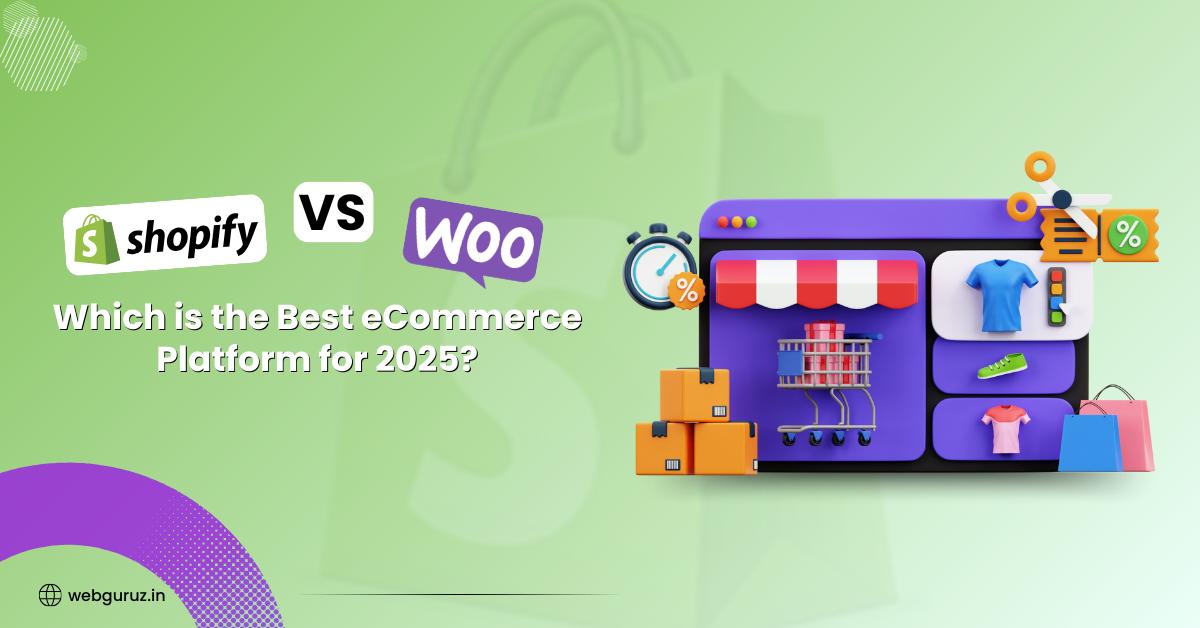Dilpreet Kaur
2025-12-25
7 min read
Top eCommerce Development Companies in the USA for 2026
Finding the right partner can make or break your online business.
Read More
If you’re planning to start an online store in 2025, you’re probably debating between Shopify and WooCommerce. These two platforms dominate the e‑commerce industry, and each has its strengths and weaknesses. Choosing the right e‑commerce website development platform for your business is crucial because it affects everything from functionality and customization to costs and scalability. So, which one should you go for?
The decision isn’t always straightforward. Shopify is an all‑in‑one solution that makes setting up an online store easy, while WooCommerce offers more flexibility and customization. To help you make the best choice, let’s dive into a detailed comparison of these two platforms, covering features, pricing, ease of use, customization options, and more.
Shopify website development services are hosted, meaning they take care of everything for you—hosting, security, and updates. You simply sign up, choose a theme, and start selling. It’s designed for people who don’t want to deal with technical complexities, making it a great choice for beginners and businesses that want a hassle‑free setup.
WooCommerce, on the other hand, is an open‑source plugin for WordPress that transforms a website into a fully functional e‑commerce store. Unlike Shopify, WooCommerce gives you complete control over your store, allowing for unlimited customization. However, it does require more technical knowledge, or the help of a WooCommerce development company, to set up and maintain.
When it comes to user-friendliness, ecommerce developers often side with Shopify. It’s built to be simple and intuitive, with a drag-and-drop interface that allows you to design your store without touching a single line of code. Everything is pre-configured, from payment gateways to inventory management, so you can launch your store quickly.
WooCommerce, while more flexible, comes with a learning curve. Since it’s a WordPress plugin, you need to set up hosting, install WordPress, and configure plugins. If you’re not familiar with WordPress, you might need to hire WooCommerce developers to help with the setup. That being said, once you get the hang of it, WooCommerce provides more control over your store’s design and functionality.
Customization is where WooCommerce truly shines. Because it’s open‑source, you can tweak every aspect of your store, from design to functionality. You have access to thousands of themes and plugins that let you add features like advanced product filters, custom checkout pages, and marketing automation. If you need a highly personalized store, working with a WooCommerce development company can help bring your vision to life.
Shopify, while offering a range of themes and apps, has limitations when it comes to deep customization. The platform restricts access to its backend code, which means you can only make changes within Shopify’s framework. If you want to go beyond the standard customization options, you may need the assistance of Shopify developers.
Shopify operates on a subscription model, with plans starting at $39/month for the Basic plan and going up to $399/month for the Advanced plan. While Shopify includes hosting and security, there are additional costs for third-party apps and transaction fees if you don’t use Shopify Payments.
WooCommerce, being free to install, seems more affordable at first glance. However, you’ll need to pay for hosting, domain registration, SSL certificates, premium themes, and plugins. The cost can vary widely depending on your choices, but it can still be a more budget-friendly option compared to Shopify if you manage expenses wisely.
If SEO is a top priority, WooCommerce might be the better choice. Since it runs on WordPress, which is known for its strong SEO capabilities, you can optimize your store with plugins like Yoast SEO. You also have full control over your hosting, meaning you can optimize your site’s speed and performance for better rankings.
Shopify also provides built-in SEO features, such as customizable meta tags and automatic sitemap generation. However, since Shopify is a hosted platform, you have less control over advanced SEO settings. If you rely heavily on organic traffic, WooCommerce offers a slight advantage.
One of the biggest advantages of Shopify is its fully managed security. Shopify takes care of SSL certificates, security patches, and regular updates, so you don’t have to worry about keeping your store safe.
With WooCommerce, security and maintenance are your responsibility. You need to choose a reliable hosting provider, install security plugins, and ensure regular backups. Some businesses hire e-commerce developers to manage these technical aspects. While this gives you more control, it also requires ongoing effort to keep your store secure.
As your business grows, your e‑commerce platform needs to scale with you. Shopify makes this process seamless. You can upgrade your plan as needed, and Shopify Plus offers enterprise-level features for high‑volume stores.
WooCommerce is also highly scalable, but performance depends on your hosting provider. If your store experiences a surge in traffic, you may need to upgrade your hosting plan or optimize your site with the help of WooCommerce developers.
If you’re looking for an easy-to-use, fully managed solution, Shopify is the way to go. It’s perfect for entrepreneurs who want to focus on selling rather than dealing with technical details. Shopify’s built-in features and dedicated support make it a great option for businesses of all sizes.
However, if you want full control and customization, WooCommerce is the better choice. It’s ideal for businesses that need a tailored e-commerce experience and are willing to invest in custom development. With the right web development service, WooCommerce can be a powerful platform for long-term growth.
Both Shopify and WooCommerce are excellent choices for e-commerce website development, but the right platform depends on your specific needs. Shopify offers simplicity and convenience, making it ideal for beginners and those who want an all-in-one solution. WooCommerce, on the other hand, provides flexibility and customization, making it a great option for businesses that want to create a unique online store.
No matter which platform you choose, investing in e-commerce website design services is essential to ensure your store is optimized for success. Whether you need Shopify developers or WooCommerce development services, working with experienced e-commerce developers can help you build a professional and profitable online store. If you’re ready to launch your store in 2025, now is the perfect time to start planning and take the next step in your e-commerce journey!

Dilpreet Kaur
2025-12-25
7 min read
Finding the right partner can make or break your online business.
Read More
Dilpreet Kaur
2025-12-25
7 min read
Sending emails and hoping for the best isn’t a strategy.
Read More
Dilpreet Kaur
2025-12-25
7 min read
Finding the right digital marketing agency can feel overwhelming. With thousands of options out there, how do you know which one will actually help your business grow?
Read More